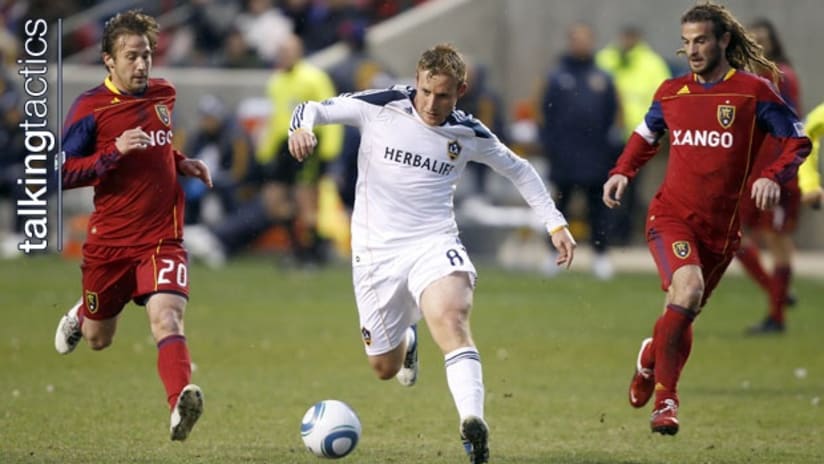As the heat rises and overly taxed legs go wobbly this summer, MLS head coaches are less inclined to employ high-pressure defense, settling instead for something more tactically tame.
So we’re seeing more low pressure around the league. What some are bound to call “negative,” others might label more reasonably as “unfortunate but necessary.” Even in cooler conditions favorable to high pressure, it’s still a far more physically demanding defensive system. So when the mercury rises, managers are more apt to lean “low” on the pressure.
Two questions to ponder: First, what exactly is low pressure? And then, how best to attack it?
Essentially, defensive systems go one of three ways, “high pressure,” “low pressure” or something in between. In high pressure, a team losing possession presses immediately to reclaim it. So they harass the man on the ball and mark aggressively off it, striving to create turnovers that turn quickly into attacks.
(These days, teams playing this all-out style fall into one of two categories: Barcelona, and those trying to imitate Barcelona. But that’s another story.)
In “low pressure” styles, the initial pressure on the ball is more about delaying rather than dispossessing. Meanwhile, numbers funnel back so that nine or 10 players take up positions behind the ball. The first earnest pressure, the first actual line of confrontation, might not occur until near the halfway line or even 10 or so yards into the defending half.
Obviously, if both teams sit back in a defensive crouch, the games would define dull and dour. Thankfully, ways exist to attack low pressure. Here are few, and which MLS teams are handy at them.
Method: Possession, possession, possession: One top example: Real Salt Lake.
Jason Kreis’ team is built to break down low pressure. The ability to retain possession through good movement, attention to spacing and precise first touches adds pressure on defenses. The banks of defenders must move and shift as RSL (or any other side) move the ball about. Eventually, holes open up.
Method: Quick transition in attack. One top example: LA Galaxy
The term “low pressure” is a wee bit misleading. That’s because there’s still initial pressure from one man, who seeks to keep the man in possession busy, make him drop his head and prevent him from scanning the field and slapping balls into dangerous places.
But teams that navigate a fast transition from defense to offense can neutralize that first burst of pressure. No MLS club does this better than the Galaxy. David Beckham’s intelligence and savvy first touch is just a bonus; everyone in a Galaxy shirt is well-drilled in quick passing and rapid forward movement that gets the attack moving immediately.
Method: Putting more numbers into the offense. Some top examples: FC Dallas, Chivas USA
Jair Benítez on the left and either Zach Loyd or Jackson on the right aren’t getting forward as much as last year; David Ferreira’s injury has made reduced the amount of offense and possession Dallas want to try. But those fullbacks still get forward with regularity, and those extra numbers in the attack add stress on defenses.
Same for Chivas USA, where Ante Jazic has added a lot to the Goats attack since returning from injury late in the spring. Same for Michael Lahoud on the right when he’s been available.
In both cases, three men are left behind to defend against the counter. FCD have Daniel Hernandez and Chivas USA have Simon Elliott, two veterans who reserve their legs for defending and distributing, and who are happy to sit protectively in front of those center backs.
Method: Switching the point of attack. One top example: LA Galaxy
This is all about Beckham. No one in MLS has ever switched play as accurately and wisely as the Galaxy’s deep-lying playmaker. Enough said there.
Method: Breaking down defenses off the dribble. One top example: Vancouver
Whitecaps attacker Davide Chiumiento doesn’t do everything perfectly, but when he gets a head of dribbling steam, good things tend to happen. Camilo, Chiumiento’s teammate in Vancouver, can do the same and did over the weekend. It’s all about good passing and movement that can create one-on-one situations; good dribblers get wide-eyed when that happens.
Method: Good passing from center backs. One top example: New York
Low pressure, as mentioned, is all about getting organized behind the ball. So slow or less aggressive passing out of the back facilitates the opposition’s low-pressure pursuits. But if you have Tim Ream and Rafa Márquez (when he’s healthy and when he’s playing center back, that is), then the passing from rear tends to be quicker, more precise and more aggressive.
Ream and Márquez can be accurate and zippy over 30 to 40 yards, which hastens the attack and reduces time for defenses to retreat into those recessed areas.
Method: Shooting from long range. One top example: Colorado
As those lines of confrontation drop ever deeper in low-pressure systems, getting behind defenders becomes ever more problematic. So teams must find ways to draw defender out. Jeff Larentowicz is among the best at shooting from 25 to 30 yards, moving into the spaces just beyond the “D” from his central midfield position.
(Teammate Brian Mullan isn’t known for his long-distance prowess, but defenders will surely pay more attention after his unchallenged hammer blow from 30 yards against Colorado last weekend.)
RSL’s Kyle Beckerman is another who can draw out defenders with a shooting threat from distance. Dwayne De Rosario does the same for D.C. United. Then again, DeRo is doing pretty much everything right these days.


